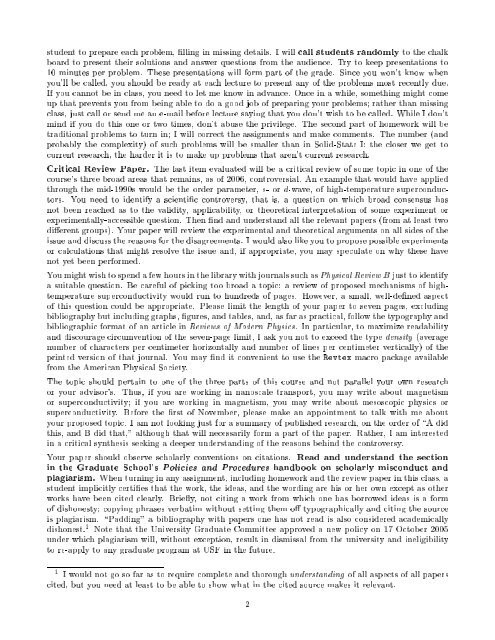syllabus - David A. Rabson
syllabus - David A. Rabson
syllabus - David A. Rabson
You also want an ePaper? Increase the reach of your titles
YUMPU automatically turns print PDFs into web optimized ePapers that Google loves.
student to prepare each problem, lling in missing details. I will call students randomly to the chalkboard to present their solutions and answer questions from the audience. Try to keep presentations to10 minutes per problem. These presentations will form part of the grade. Since you won't know whenyou'll be called, you should be ready at each lecture to present anyof the problems most recently due.If you cannot be in class, you need to let me know in advance. Once in a while, something might comeup that prevents you from being able to do a good job of preparing your problems; rather than missingclass, just call or send me an e-mail before lecture saying that you don't wish to be called. While I don'tmind if you do this one or two times, don't abuse the privilege. The second part of homework will betraditional problems to turn in; I will correct the assignments and make comments. The number (andprobably the complexity) of such problems will be smaller than in Solid-State I: the closer we get tocurrent research, the harder it is to make up problems that aren't current research.Critical Review Paper. The last item evaluated will be a critical review of some topic in one of thecourse's three broad areas that remains, as of 2006, controversial. An example that would have appliedthrough the mid-1990s would be the order parameter, s- or d-wave, of high-temperature superconductors.You need to identify a scientic controversy, that is, a question on which broad consensus hasnot been reached as to the validity, applicability, or theoretical interpretation of some experiment orexperimentally-accessible question. Then nd and understand all the relevant papers (from at least twodierent groups). Your paper will review the experimental and theoretical arguments on all sides of theissue and discuss the reasons for the disagreements. Iwould also like you to propose possible experimentsor calculations that might resolve the issue and, if appropriate, you may speculate on why these havenot yet been performed.You might wish to spend a few hours in the library with journals suchasPhysical Review B just to identifya suitable question. Be careful of picking too broad a topic: a review of proposed mechanisms of hightemperaturesuperconductivity would run to hundreds of pages. However, a small, well-dened aspectof this question could be appropriate. Please limit the length of your paper to seven pages, excludingbibliography but including graphs, gures, and tables, and, as far as practical, follow the typography andbibliographic format of an article in Reviews of Modern Physics. In particular, to maximize readabilityand discourage circumvention of the seven-page limit, I ask you not to exceed the type density (averagenumber of characters per centimeter horizontally and number of lines per centimeter vertically) of theprinted version of that journal. You may nd it convenient to use the Revtex macro package availablefrom the American Physical Society.The topic should pertain to one of the three parts of this course and not parallel your own researchor your advisor's. Thus, if you are working in nanoscale transport, you may write about magnetismor superconductivity; if you are working in magnetism, you may write about mesoscopic physics orsuperconductivity. Before the rst of November, please make an appointment to talk with me aboutyour proposed topic. I am not looking just for a summary of published research, on the order of \A didthis, and B did that," although that will necessarily form a part of the paper. Rather, I am interestedin a critical synthesis seeking a deeper understanding of the reasons behind the controversy.Your paper should observe scholarly conventions on citations. Read and understand the sectionin the Graduate School's Policies and Procedures handbook on scholarly misconduct andplagiarism. When turning in any assignment, including homework and the review paper in this class, astudent implicitly certies that the work, the ideas, and the wording are his or her own except as otherworks have been cited clearly. Briey, not citing a work from which one has borrowed ideas is a formof dishonesty; copying phrases verbatim without setting them o typographically and citing the sourceis plagiarism. \Padding" a bibliography with papers one has not read is also considered academicallydishonest. 1 Note that the University Graduate Committee approved a new policy on 17 October 2005under which plagiarism will, without exception, result in dismissal from the university and ineligibilityto re-apply to any graduate program at USF in the future.1 Iwould not go so far as to require complete and thorough understanding of all aspects of all paperscited, but you need at least to be able to show what in the cited source makes it relevant.2


